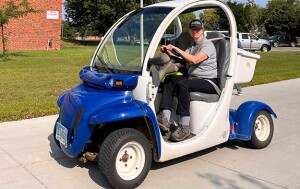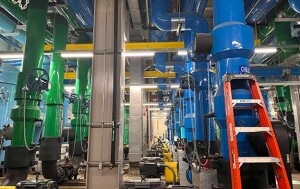Austin Wixon is ready to get the day started. It’s 4:58 a.m. as he gathers his 25-person custodial crew for a brief meeting before they scatter around campus to get started on the day’s work. He double-checks with his two brothers, Todd and Danny, who lead the evening and overnight crews, to see if there’s any extra work on campus that his morning crew needs to tend to.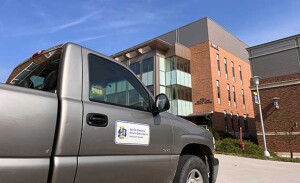
“It’s a team effort,” Wixon said. “We always are willing to help the other crews out to get stuff done.”
A team effort is exactly what it takes to tend to the 4,239,730 square feet of building space on South Dakota State University’s 512-acre main campus. While Facilities and Services might not get much recognition, its staff do the foundational work—from vacuuming floors to clearing snow to fixing HVAC systems—that must happen for campus to function properly.
The day-to-day
Amy Jones, director of campus maintenance services, had plans to check on the interior work at Lincoln Hall this morning, but her radio has been going off nonstop. It’s 9:30 a.m. and a team member just called her about a water line break. Jones’ day is turning out to be—like many days—predictably unpredictable.
“You never know what will come up,” Jones said. “This job keeps you on your toes, that’s for sure.”
Jones, a professional engineer with a master’s degree from Georgia Tech and an undergraduate degree from Purdue University, oversees a team of 45 professionals who are experts in a variety of trades, including locksmiths, electricians, plumbers, carpenters, mechanics, groundskeepers and welders—all essential to finish projects both big and small on campus.
Campus flowers
On the way to the day’s surprise job site, Jones visits with the department’s horticulturist, Tanner Aiken ’11, and Courtney Birkholtz ’16, a grounds services team member, as they review Birkholtz’s design to revitalize a landscape bed on campus.
“We plant over 10,000 annuals throughout campus, usually toward the middle of May,” Aiken said. “All are grown in our greenhouse from either seeds or plugs during the spring, an effort that is led by (Birkholtz).”
Aiken’s work includes more than just the annuals that dot the landscape beds throughout campus. He is also responsible for overseeing tree diversity on campus. This requires special consideration to the few remaining ash and Dutch elm trees, both of which are threatened by invasive beetles.
Like everyone else in the department, Aiken has his share of unpredictable days. One of the most memorable occurred in 2018, when a group of “enterprising” students decided to do some “toilet-papering” to the trees outside of the HPER building, just days before graduation was set to be held.
Aiken, along with Ryan Hoffman ’00, physical plant manager for ground services, quickly sprang into action and devised a plan to remove all the toilet paper in time for graduation: they would spray the trees with water until all the paper was gone. It took longer than anticipated, but Aiken and Hoffman were able to remove nearly all of it before thousands of visitors descended on campus.
“There might still be toilet paper up in those trees,” Aiken joked.
Jones arrives at the site of the water line break just before 11 a.m. While this particular type of project is rare, it is highly important that it is fixed as quickly as possible. Todd Kimball, a plumber by trade, has already isolated the break’s location and is working with other crew members to rectify the situation.
“This is really what makes my crew—and the rest of the department—great,” Jones said. “They take so much pride in their work and are extremely committed to SDSU.”
The mail room
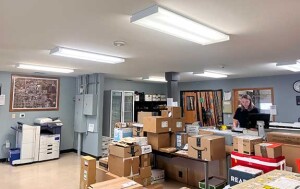 It’s nearly 1 p.m. and the mail has just been dropped off by the postal service. Each day, more than 1,000 packages are delivered to campus, which are then sorted by staff members on the shipping, receiving and warehouse team. Once it’s sorted by building, they will each set off on their daily deliveries, dropping off boxes throughout campus. The biggest deliveries are often to the dorms during the fall semester.
It’s nearly 1 p.m. and the mail has just been dropped off by the postal service. Each day, more than 1,000 packages are delivered to campus, which are then sorted by staff members on the shipping, receiving and warehouse team. Once it’s sorted by building, they will each set off on their daily deliveries, dropping off boxes throughout campus. The biggest deliveries are often to the dorms during the fall semester.
The mail falls under the business operations sector of the department. Headed by Jennifer Kindt ’15, who has been with the university for over 20 years, the 16-person business operations team does the “invisible” work for the department, including handling the bills, accounts, inventory, purchasing, project accounting and all the other finances that comes with a department the size of Facilities and Services.
Projects both big and small
David Law ’98 is headed to a meeting regarding the largest ongoing campus project: First Bank & Trust Arena. As the director of project management and engineering, Law and his team of project managers oversee all the major building projects at SDSU. While the arena project is the most visible, the three-person team is often overseeing over 90 projects—both big and small—on campus.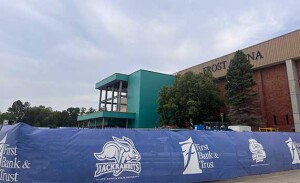
“Our role is to be the liaison with customers and the stakeholders,” Law said. “We’re also doing the contract management, the quality control, the day-to-day coordination of minor details, like turning off the lights because the construction team has to make a connection the next day. It’s lots and lots of detail-oriented work.”
Like many employees in the department (particularly in leadership roles), Law is a Jackrabbit lifer. As both an SDSU graduate and an employee for over 20 years, Law has had a direct hand in the campus’ expansion over the past decade. Some of the more memorable projects have been Dana J. Dykhouse Stadium, the Avera Health and Science Center and the Sanford-Jackrabbit Athletic Complex.
“When you’re standing there watching the ribbon-cutting ceremony, there’s a real sense of pride,” Law said. “Pride in not only the work we have done but for the university as a whole.”
Powering campus
The afternoon sun is high in the sky while Barry Mielke ’02/M.S. ’18, associate vice president for Facilities and Services, sits at his desk. Mielke oversees all 188 full-time staff members in the department—the largest of any at SDSU. Prior to his role as VP, Mielke—another Jackrabbit lifer—served as the department’s energy systems director. Now headed by interim director Bob Milbrandt ’06, the energy systems sector, collectively, can be seen as the heating and cooling plants of the university.
During the winter, the Central Heating Plant—which heats nearly 90% of campus—is staffed 24/7.
“From October until May, there is always someone overseeing the plant,” Milbrandt said. “We call this ‘Firing Season.'”
In 2012, the plant went through a significant shift, moving from coal-burning boilers to natural gas boilers. This shift signified the last time SDSU burned coal as an energy source. The results—coupled with solar panels, more efficient installation and more efficient HVAC systems—have led to a far more energy-efficient campus and, despite the campus’ increase in square footage, the energy consumption per square foot has actually decreased.
“We can’t control utility prices, but through efficient operation of buildings and designing and installing efficient equipment, we can keep those costs in check,” Mielke explained.
The work never stops
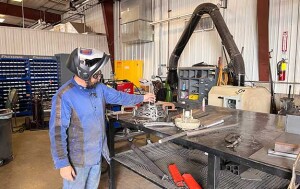
Andrew Frederickson, a welder by trade, fixing a nearly century-old light fixture for the Coughlin Campanile.
Before Jones can get to her original plans for the day, she has to make a quick stop at the equipment shop to visit with the foreman, Herb Saathoff. A few weeks prior, Jones had noticed that a light on the Coughlin Campanile was broken. To preserve the nearly century-old light fixture, Saathoff and Andrew Frederickson, a welder by trade, were at work making a new casing.
It’s nearly 3 p.m. and Jones has made her way over to Lincoln Hall, but not before noticing some painting that needs to be finished. Like a farm, there’s always something to do on campus—the work never really stops. She adds it to her to-do list and heads into Lincoln Hall. For now, the paint will have to wait.
“I’ll save that for tomorrow,” Jones explains. “Besides, every day is a new adventure.”
Addison DeHaven

